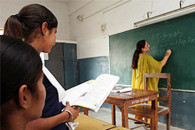Aziz Dheri and the footprints of Buddhism in K-P
Buddhist remains in Swabi of the Gandharan civilisation, include the largest stupa found in the subcontinent.
1675580489-3/Aziz-Dehri-(5)1675580489-3-640x480.webp)
The province of Khyber Pakhtunkhwa holds cultural significance for its Buddhist and Hindu heritage dating back to the Gandhara civilisation. Rare artefacts found in various districts of the province have made the region a centre of attention for tourists and archeologists from all over the world.
If we look at Swabi district, it houses a web of ruins of ancient religious buildings. Almost every village here has temples belonging to Hinduism and Buddhism, and there are a number of Sikh gurdwaras situated here as well.
Prominent archaeologist and former Provincial Director of Museums and Archeology Dr Shah Nazar Khan has conducted research across Khyber Pakhtunkhwa, including Swabi district, and has discovered a trove buried treasures. One of the most extraordinary among these archaeological finds is Aziz Dheri, a Buddhist mound located at a distance of about 12 km from Gohati on the Mardan-Swabi Road.
Aziz Dheri covers 110 kanals of land. It is named after a famous religious scholar Aziz Khan, who hailed from Sheikh Jana in Swabi district, two hundred years ago. The area was first surveyed in 1976 by an American expert from Temple University, US. Before 1999, there was illegal excavation was carried out on the important archaeological site. However, the site was later closed by the government.
Excavation was resumed in 1998.
1675580495-11/Aziz-Dehri-(15)1675580495-11.jpeg)
Discoveries of an ancient past
Dr Shah Nazar Khan conducted the last excavation at Aziz Dheri in 2013, which uncovered the largest stupa (tomb of Buddha) in the Indian subcontinent. Three other smaller stupas were also discovered. Archeologist Prof Dr Naeem Qazi was project director for the excavation. “The work I did in Aziz Dheri excavation is the best work of my life,” he says proudly. “The people [who helped in the digging] here are hardworking and hospitable. They aided me a lot.”
The Archeology Department of Khyber Pakhtunkhwa had been receiving complaints about people illegally excavating statues and other artefacts from Aziz Dheri and selling them. It was recommended that the government should take the site in its custody, according to Dr Shah Nazar Khan. In 1996, the Directorate of Archeology and Museums decided to design a project for the preservation of Aziz Dheri and declared it an archeological site. Dr Shah Nazar Khan was made the project director and proper excavation started there. The archeology department was responsible for preserving the relics that were found.
1675580492-13/Aziz-Dehri-(17)1675580492-13.jpeg)
Dr Qazi says that Aziz Dheri was a happening place from the second century to the seventh century. According to Shah Nazar Khan, the site is important for three salient features: being the ruins of a city; the stupa’s big worship place and having a colony which solitaries used for seclusion. There were many such colonies in cities and on sites of worship places in the Buddhist tradition. Dr Shah Nazar Khan says that Aziz Dheri is the only place where all these three things are present simultaneously: residential quarters, places of worship and hostels for seclusion.
There are about 12 rooms in the Aziz Dheri settlement. These are made of marble which is found in Tarkoghond area near Ranigat, in Buner Valley, where more Buddhist ruins are found. There are residential quarters specific to the large stupa. There is a kitchen, dining hall and washrooms. The walls are high. A large number of statues, utensils, baked earthen pots and items of daily use have been found from Aziz Dheri. Coins, stone hand-mills for grinding grain (querns) and mortars were also found. There are many smaller statues of the Buddha around the big stupa.
1675580493-5/Aziz-Dehri-(8)1675580493-5.jpeg)
The statues are artistic masterpieces. They have a cast of Roman and Greek influence on them which indicates the diplomatic contacts of that period. The statues show that the people here used chappals and cloth from Rome. They indicate that these people had high noses and wide faces like the Greeks.
A big statue is erected in a prayer place in Aziz Dheri and there is a dhaba (donkacha) where the worshippers used to rest after prayers.
Items found from Aziz Dheri so far are placed in Hund Museum in Swabi. The museum houses a whole pot of money with 532 coins in it. Some of these coins belong to the Sasanians of the Kushan Empire (2nd to 3rd century) while others belong to the Hindu dynasty era. Iron nails which were used for woodworks and to bolster the stairs have been found during excavations. The graves here are decorated with statues. There are lanes and verandas. The roofs of some of the rooms are made with wood. You can’t see the wood now but its traces are visible. Some pots found here were used for potable water including eight big pitchers; one big earthen pot was full of lime used for plastering.
1675580501-12/Aziz-Dehri-(16)1675580501-12.jpeg)
The floors are laid with bricks with lime pasted on them. There are beautiful red and green lotus flowers made on the floor. The presence of flowers in the prayer room shows that lotus flowers were considered sacred in their religion. Lotus is also called ‘pushkla’. Barsanda flowers are called ‘kanwal’ in Charsadda. In fact, the old name of Charsadda is Pushkalawati which means ‘city of barsandas’. Barsanda is a very tasty vegetable and is also a special food in Charsadda when cooked with mince.
The archeology department has preserved the big stupa and guards are appointed for 24 hours here. Aziz Dheri was governed by the Sasanis, the Kushans and the Hindu dynasty. Locals say that Mehmud Ghaznavid period coins and rare items are found here.
1675580489-0/Aziz-Dehri-(1)1675580489-0.jpeg)
Other significant Buddhist mounds
There are 10 more Dheris of that period near Aziz Dheri. Naugram is situated at a little distance from here. Ranigat is located on a very high mountain. Dr Shah Nazar Khan writes in his book Taliparona that Swabi enjoys fame for the remains of the Ghandhara civilization, Hindu dynasty and Buddhism. Here are historical remains at Asota Gatay, old Swabi, Karamar, Chhota Lahore, old graves of Adeena, Aziz Dheri, Ranigit, Naugram, Predab and Tarlandi Hill. “Khyber Pakhtunkhwa is a rich region from this point of view as every village and town has such remains here,” Dr Shah Nazar Khan says.
Aziz Dheri, with its big stupa, is declared a heritage site of international status and Buddhists hold it in high regard. This is the biggest of all stupas in Pakistan and it is a rare one. According to Dr Shah Nazar Khan, many small statues are instituted around it which are some of the best examples of stone carving. They depict the Buddha at various ages; when he was born or at the age of two years and so on. Similarly, the various stages of his life are depicted in these intricately carved statues which have been displayed on the steps all the way down.
1675580483-2/Aziz-Dehri-(3)1675580483-2.jpeg)
The steep walls were made as defence from attacks from followers of other religions. These walls were impossible to climb because of their slipperiness. Rare stone from Tarkondo and marble were used for these walls. The stone was brought as raw pieces and then carved into shapes and used in the walls.
There is one more stupa at Aziz Dheri which is situated very high with beautiful steps lead up to it. On every step skillfully carved statues of the Buddha have been installed. We see here the influence of Greek, Roman and Persian art. When the followers of Buddha would climb the stairs, they would offer special prayers at the sight of every statue at each step.
Kushan dynasty coins found from Aziz Dheri are 2,500 years old. Before this excavation people had dug, stolen and sold coins and antiques that they found from here.
1675580500-14/Aziz-Dehri-(19)1675580500-14.jpeg)
All the antiques, statues and other things of use found here in 2012 were preserved carefully and later placed in Hund Museum. The Directorate of Archives and Museums has done a lot of work in Aziz Dheri but provincial and central government should also play their roles here and open this place for public. This will promote tourism and everyone will be able enjoy such historical places. According to Dr Shah Nazar Khan, Pakistan is the only country in the world where rare things belonging to every historical era are present.
In his most recent interview, Dr Shah Nazar Khan recommended that establishing museums at the sites if archaeological importance will provide a fillip to tourism as well as research. It is time, he says, that the Archives Department lays the foundation of a museum in Aziz Dheri, and also at the archaeological mounds of Shahbaz Garhi and Takhtbahai. “All the coins, antiquities and statues found from Aziz Dheri should be displayed in this museum so that the people who visit the site could see these things and carry a good impression of our country with them,” says Dr Shah Nazar Khan.
1675580484-7/Aziz-Dehri-(11)1675580484-7.jpeg)
“If the central and the provincial governments pay special attention to Aziz Dheri, it can be developed on an international level,” says Dr Khan. “If full attention is paid to this site and its importance, it will prove to be one of the best tourist attractions. This whole area will shine because of Aziz Dheri.” When it catches the attention of the world, international institutions will come to visit and the five other historic mounds in Khyber Pakhtunkhwa will also receive more attention. The provincial directorate of archives will take special interest in it and a new period of digging will start.”
Dr Muhammad Ali Jauhar Yusufzai is a senior journalist, radio presenter and broadcaster based in Khyber Pakhtunkhwa. All facts and information are the sole responsibility of the writer.



















COMMENTS
Comments are moderated and generally will be posted if they are on-topic and not abusive.
For more information, please see our Comments FAQ